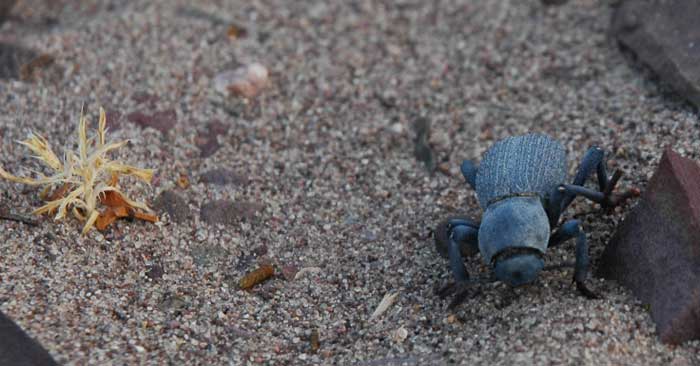^A tenebrionid beetle near Big Dune.
OHV Designation to be Changed by BLM
April 6, 2011 - Bureau of Land Management Pahrump Field Manager Mark Spencer told us at a meeting in Primm, Nevada, that Pacific Solar's large photovoltaic project sits partly on land specially designated for recreation use, part of the Big Dune off-road area. He said BLM would seek to change the land designation to accommodate Pacific Solar, as a Plan Amendment. The solar project is currently in the process of having an environmental document produced, and BLM is working on the alternatives analysis.
Endemic Dune Beetles Present
January 3, 2010 - Amargosa Valley, Nevada
The Proposed Pacific Solar Investments Inc.(a subsidiary of Iberdrola of Spain), Amargosa North Solar Project, Nye County, Nevada, may affect many rare sand dune endemics.
The Las Vegas Bureau of Land Management (BLM) published a Notice of Intent to Prepare an Environmental Impact Statement for a cadmium-telluride thin-film photovoltaic solar energy project on 7,500 acres of public land northeast Big Dune in the Amargosa Valley, Nevada. The notice, published in the Federal Register on December 14, 2009, opens a 60-day public comment period that will end on February 12, 2010.
Giuliani’s big dune scarab beetle (Pseudocotalpa giulianii) was proposed for listing as a threatened species under the Endangered Species Act in August 1978. In addition, the entire Big Dune Complex was proposed as critical habitat for the species. Off-road vehicle use was identified as the largest threat to the species at the time.
Three other rare and sensitive beetle species can also be found at Big Dune:
• Large Aegialian Scarab Beetle (Aegialia magnifica)
• Rulien’s miloderes weevil (Miloderes rulieni)
• Big Dune aphodius scarab beetle (Aphodius sp.)
The more widespread Dune tenebrionid beetle (Eusattus muricatus) is found on Big Dune, as well as other dune systems in the Mojave Desert and Great Basin. It is flightless and fossorial (burrows into the sand).
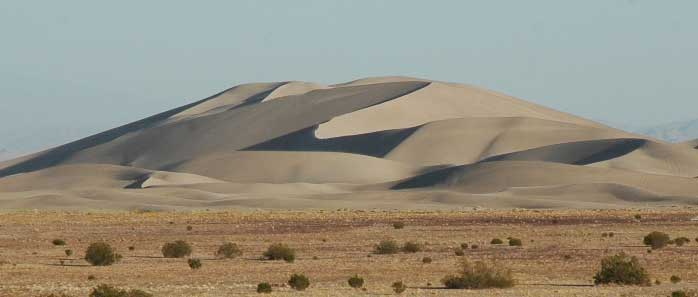
Big Dune is a a 1.5-mile complex star dune, 2,731 feet in elevation. The entire dune area is an Area of Critical Environmental Concern (which does not prevent OHV use), and 5 acres are specifically protected for the beetles.
Mojave Desert plant communities includes Creosote bush (Larrea tridentata), Sandpaper
plant (Petalonyx thurberi), Prickly poppy (Argemone corymbosa) and Milkvetch (Astragalus lentiginosus var. variabilis). "These plants and the dune itself are very important for survival of these rare beetle species," says BLM. All four Big Dune beetle species rely on dune plants for survival. The plants provide food and mating sites and, when covered with sand, shelter and food for their larvae. The beetles also burrow into the harder layers of sand below the loose, wind blown dune surface when they are inactive. Taking thousands of acres of vegetation and grading them for a photovoltaic field will be a heavy impact for these insects.
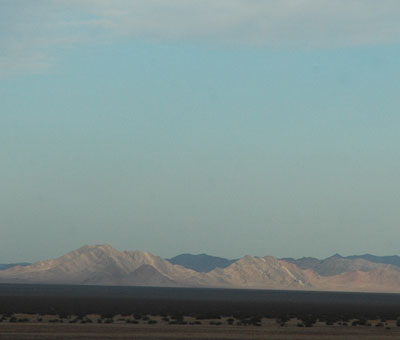 Desert tortoises inhabit the area as well.
Desert tortoises inhabit the area as well.
BLM is accepting Pacific Solar's Plan of Development, despite the appearance that it is deficient on all subjects.
Water use at the project will be limited to human consumption, dust suppression, and solar panel cleaning.
The proposed solar energy project would produce approximately 150 megawatts of electricity, and would be located on approximately 2,356 acres within a 7,500 acres right-of-way on public lands in the Amargosa Valley, Nye County, Nevada.
Greg Helseth, BLM renewable energy project manager, said the project would be constructed in three phases, 50 megawatts at a time. Pacific Solar plans to construct its own transmission line to the Johnnie substation.
"The actual area they're going to construct is much closer to the main road there. As we move along in the process, they may give up a lot of that area that's close to the Big Dune. The Big Dune is an ACEC," Helseth said. He added, "Any blowing sand can't be too good for PV panels." This project is not on the Department of Interior's Fast-Track list for renewables. (From Pahrump Valley Times >>here.)
A concern with blowing sand, too, is the potential wear and tear on the panels, which could release toxic Cadmium particles into the air. (See this article Cadmium: The Dark Side of Thin-Film? in Earth2Tech.com)
We obtained the Plan of Development from BLM: download the pdf >>here (large file-40.1 MB).
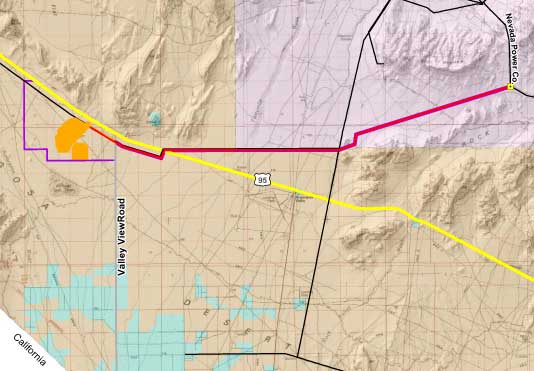
^Map of the proposed Pacific Solar photovoltaic development, in orange. The project site boundary is in purple. The thick red line is the proposed new transmission line that would have to be built.
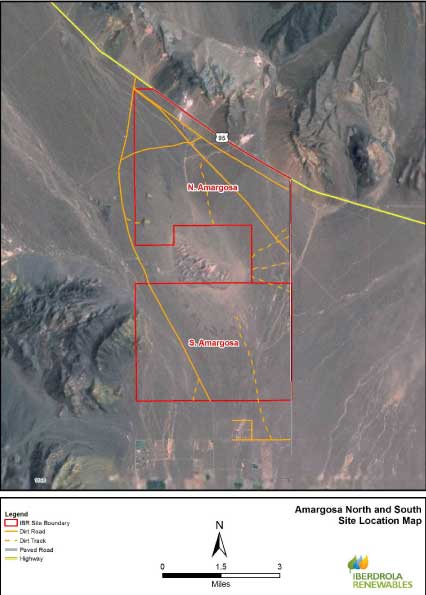
^Map showing the proposes Pacific Solar North and South projects, surrounding Big Dune. This will conflict with OHV use drastically.

^Area map, showing Pacific Solar North project area in bold black dashed line, and the photovoltaic panel areas, phase 1, 2, and 3 in colors. Valley View Road lies on the right, a main access road for recreationists to Big Dune. Number 1 at the blue dot in the upper left represents the location where we found a Miloderes weevil. A significant area of sand habitat (gray) lies within the proposed project area. Conflicts with OHV users will occur if the project is approved as is. The entire project area also lies in Desert tortoise habitat.

^Pacific Solar's Plan of Development gives this picture of what their proposed photovoltaic project would look like.
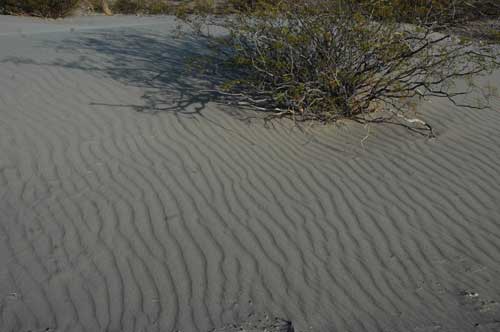
^Little sand areas lie away from the main dune, to the east. This is where we found the rare weevil. According to the map on Pacific Solar's Plan of Development, this habitat lies within their project boundary.
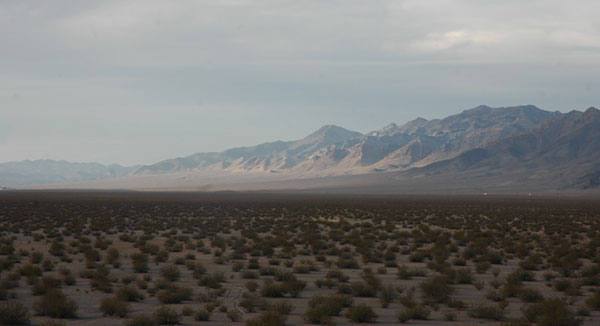
^View from the project area northeast towards Highway 95 and the Bare Mountains.
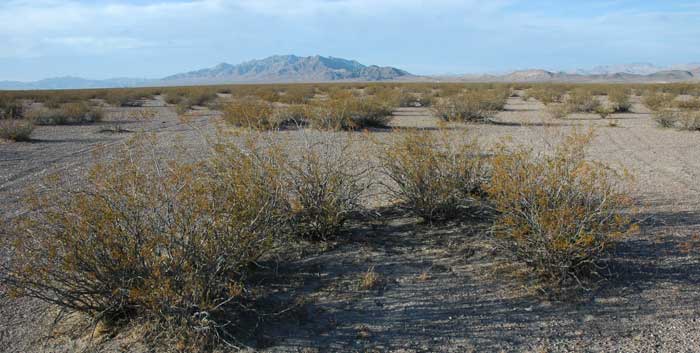
^Ancient Creosote ring that may be thousands of years old, on the project site.

^BLM closed a dirt road just north of the project site.
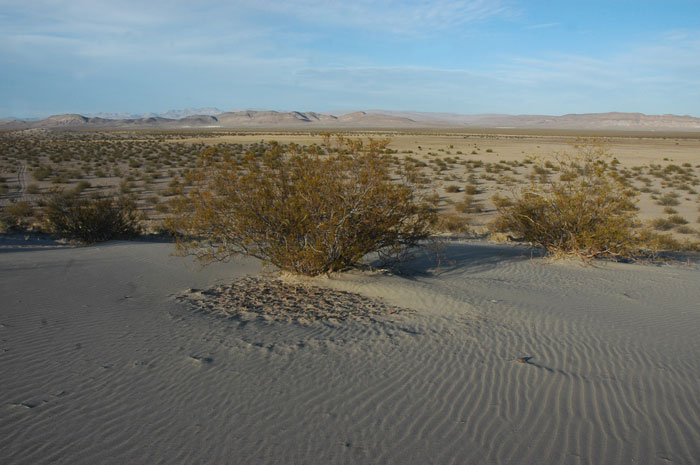
^Small dune with rare weevils, within the project boundary, looking southeast. A sand sheet covers the flat in the distance.
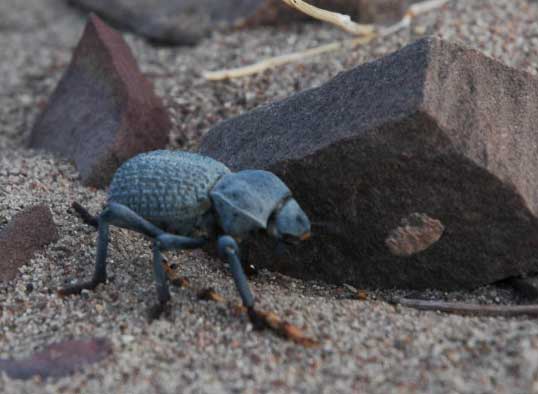
^A tenebrionid beetle on a small sand patch in the project site for the solar development.
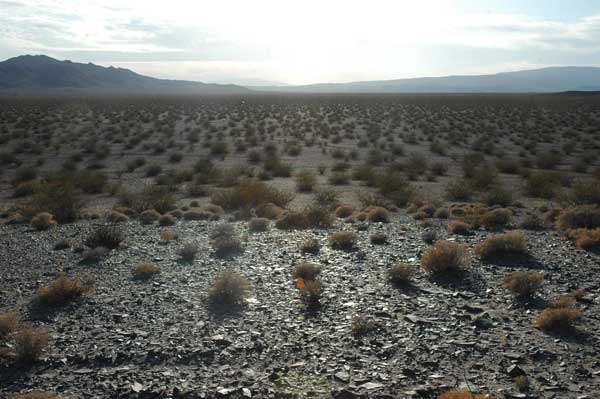
^View from the northwest edge of the project site looking west towards Death Valley National Park hills.
Send Comments
Written comments may be mailed to the BLM, Southern Nevada District, Renewable Energy Projects Manager, 4701 N. Torrey Pines Drive, Las Vegas, NV 89130, or emailed to NorthSolar_Proj@blm.gov. For more information, please call Greg Helseth at 702-515-5173.
News Release, Pahrump BLM Field Office >>here.
HOME .....Amargosa Valley Solar Millennium Farm Road Project
